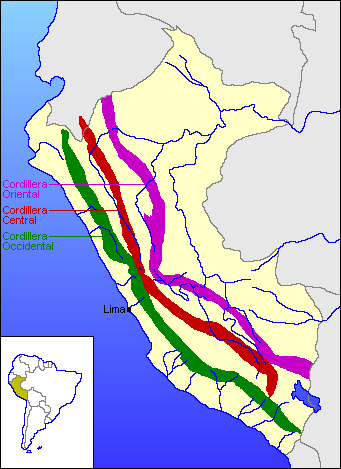Presencia de Glaciares
Perú está ubicado en el lado occidental de América del Sur entre las latitudes 0° y 18°S. y las longitudes 69° y 81°W; está atravesado por el gran sistema montañoso de Los Andes que se extiende a lo largo de todo el lado occidental de América del Sur. Amplias áreas de este sistema montañoso están cubiertas de glaciares. Los Andes peruanos comprenden tres grandes cordilleras (ver la siguiente figura):
- La Cordillera Occidental en el oeste,
- La Cordillera Central en el medio,
- La Cordillera Oriental en el este.
La elevada altitud promedio de las tres cordilleras, junto con las condiciones climáticas regionales y locales, ha resultado en el desarrollo extenso de glaciares en muchas ubicaciones. De hecho, Los Andes peruanos tienen la mayor área de glaciares tropicales en la Tierra. Se estima que el área total cubierta de hielo es de 2,600 km². La altitud mínima promedio de los glaciares en Perú es de 4,800 m sobre el nivel del mar (snm). En la discusión que sigue, las áreas glaciadas se han agrupado en 20 cordilleras distintas. Cada una de estas áreas se describe brevemente, primero aquellas en la Cordillera Occidental, seguidas por aquellas en la Cordillera Central y luego aquellas en la Cordillera Oriental. Dentro de cada cordillera, las áreas se describen de norte a sur. El glaciar individual más grande, el casquete glaciar Quelccaya, está en la Cordillera de Vilcanota. De los siguientes 11 glaciares más grandes, 8 se encuentran en la Cordillera Blanca.




